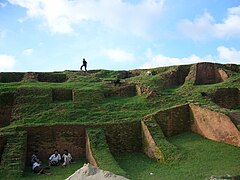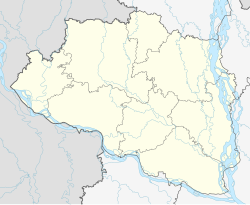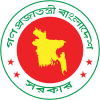Bogra
 From Wikipedia - Reading time: 13 min
From Wikipedia - Reading time: 13 min
Bogra
বগুড়া Bogra | |
|---|---|
| Bogura | |
From top: Gokul Medh, Sathmatha, Delta Tower, Bogra Railway Station, Azizul Haque College | |
| Coordinates: 24°51′N 89°22′E / 24.850°N 89.367°E | |
| Country | |
| Division | Rajshahi |
| District | Bogra |
| Upazila | Bogra Sadar |
| Pundravardhana | 1280 BC |
| Municipal Council | 1 July 1876 |
| Government | |
| • Type | Mayor–Council |
| • Body | Bogra Municipality |
| • Mayor | Rezaul Karim Badsha |
| Area | |
• Total | 71.56 km2 (27.63 sq mi) |
| Elevation | 20 m (70 ft) |
| Population (2022)[1] | |
• Total | 485,944 |
| Time zone | UTC+6 (BST) |
| Postal code | 5800 |
| Calling code | 051 |
| Website | www |
Bogra (Bengali: বগুড়া), officially known as Bogura,[2] is a city located in Bogra District, Rajshahi Division, Bangladesh. The city is a major commercial hub in Northern Bangladesh. It is the second largest city in terms of both area and population in Rajshahi Division.[3][4]
Bogra is named after Nasiruddin Bughra Khan, the Governor of Bengal from 1279 to 1282 and the son of Delhi Sultan Ghiyasuddin Balban.[5] The city is approximately 71.56 km2 (27.63 sq mi) and is divided into 21 wards. Bogra has a population of around 12,40,000 people. Since it is one of the oldest cities in Bengal, Bogra is famous for its many ancient Buddhist stupas, Hindu temples, and ancient palaces of Buddhist kings and Muslim sultans.
The city has produced notable personalities including Prime Minister Muhammad Ali Bogra of Pakistan, President Ziaur Rahman of Bangladesh, both of whom were born and lived in the city.
History
[edit]Bogra is considered the oldest city of Bengal, dating to the reign of the Great Emperor Ashoka, who ruled India from 268 to 232 BCE. When Ashoka conquered the Bengal (Bongo) region, he founded Bogra and called it Pundra Bardhan. This is supported by the discovery in October 2008 of an ancient engraved stone believed to be produced in the Gupta era near Sura Mosque at Ghoraghat Upazila in Dinajpur.
Bogra has been a transportation, cultural and economic hub for thousands of years. In the early 800AD, it was a core place of doing business through the Karatoya River (a sub-river of the Bangali River, not to be confused with the Large Karatoya River). By 1200 AD it had also become an important geopolitical center for spreading Islam through the Mahasthangarh. In the late fiftieth century, it became a statistical trade area by the British East India Company.
In the late seventeenth century, the British East India Company gave control of the area to Nowab and Shatani families, who still are two of the most reputed families in the city.
During the Bangladesh War of Independence, the area witnessed the Battle of Bogra, a fierce conflict between the guerrilla units of the Bangladesh Forces under Sector 7 and the Pakistan Army.
Climate
[edit]The city enjoys a monsoon-influenced humid subtropical climate (Köppen Cwa) bordering on a tropical savanna climate (Köppen Aw), with two main seasons: winter and summer. Winters are dry with warm afternoons and cool nights (although frosts have never occurred in recent history), while summers are hot and humid with heavy rainfall due to the monsoon season.
| Month | Jan | Feb | Mar | Apr | May | Jun | Jul | Aug | Sep | Oct | Nov | Dec | Year |
|---|---|---|---|---|---|---|---|---|---|---|---|---|---|
| Record high °C (°F) | 31.1 (88.0) |
34.8 (94.6) |
40.6 (105.1) |
44.0 (111.2) |
41.5 (106.7) |
40.6 (105.1) |
37.9 (100.2) |
37.7 (99.9) |
38.4 (101.1) |
37.4 (99.3) |
34.5 (94.1) |
32.0 (89.6) |
44.0 (111.2) |
| Mean daily maximum °C (°F) | 24.0 (75.2) |
27.6 (81.7) |
31.4 (88.5) |
33.3 (91.9) |
33.4 (92.1) |
33.1 (91.6) |
32.4 (90.3) |
32.7 (90.9) |
32.5 (90.5) |
32.1 (89.8) |
30.2 (86.4) |
26.1 (79.0) |
30.7 (87.3) |
| Daily mean °C (°F) | 17.3 (63.1) |
21.1 (70.0) |
25.3 (77.5) |
27.8 (82.0) |
28.4 (83.1) |
29.0 (84.2) |
29.0 (84.2) |
29.2 (84.6) |
28.5 (83.3) |
26.7 (80.1) |
22.8 (73.0) |
18.6 (65.5) |
25.3 (77.5) |
| Mean daily minimum °C (°F) | 11.6 (52.9) |
14.7 (58.5) |
19.3 (66.7) |
22.8 (73.0) |
24.2 (75.6) |
26.0 (78.8) |
26.4 (79.5) |
26.6 (79.9) |
25.9 (78.6) |
23.6 (74.5) |
18.5 (65.3) |
13.9 (57.0) |
21.1 (70.0) |
| Record low °C (°F) | 4.5 (40.1) |
6.7 (44.1) |
10.6 (51.1) |
16.7 (62.1) |
17.3 (63.1) |
19.4 (66.9) |
21.1 (70.0) |
21.7 (71.1) |
21.1 (70.0) |
17.2 (63.0) |
11.0 (51.8) |
4.9 (40.8) |
4.5 (40.1) |
| Average precipitation mm (inches) | 8 (0.3) |
15 (0.6) |
21 (0.8) |
82 (3.2) |
210 (8.3) |
309 (12.2) |
338 (13.3) |
278 (10.9) |
277 (10.9) |
151 (5.9) |
7 (0.3) |
7 (0.3) |
1,703 (67) |
| Average precipitation days (≥ 1 mm) | 1 | 2 | 3 | 6 | 13 | 16 | 20 | 19 | 16 | 8 | 1 | 1 | 106 |
| Average relative humidity (%) | 71 | 64 | 62 | 71 | 76 | 82 | 83 | 82 | 83 | 78 | 73 | 73 | 75 |
| Mean monthly sunshine hours | 188.4 | 212.9 | 239.4 | 215.1 | 197.0 | 148.2 | 150.0 | 155.9 | 159.0 | 222.2 | 226.8 | 203.4 | 2,318.3 |
| Source 1: NOAA[6] | |||||||||||||
| Source 2: Bangladesh Meteorological Department (humidity 1981-2010)[7][8] | |||||||||||||
Demographics
[edit]According to the 2022 Bangladesh census, Bogra city had a population of 485,944.[1]: 388–394
According to the 2011 Bangladesh census, Bogra city had 81,251 households and a population of 350,397. 61,645 (17.59%) were under 10 years of age. Bogra had a literacy rate (age 7 and over) of 72.16%, compared to the national average of 51.8%, and a sex ratio of 905 females per 1000 males.[9]
Economy
[edit]Since the 2009 adoption of new urban planning, there has been a significant development in the infrastructure of Bogra. This includes the restructuring and widening of roads, improvement of telecommunications infrastructure, and the installation of underground gas connections.
Additionally, red chili production in Bogra is a major industry, with companies such as Square, Acme, and BD Food collecting red chili from twelve centers within Bogra.[10]
Often called the "Town of Banks", Bogra is the location of numerous online banking facilities, credit card, debit card, and remittance companies. Banking in Bogra has significantly expanded with the presence of government banks such as the Bangladesh Bank (Central Bank), Sonali Bank, Rupali Bank, Janata Bank, Rajshahi Krishi Unnayan Bank, Bangladesh Development Bank Ltd., Uttara Bank Ltd, and Agrani Bank, as well as a number of private and specialized banks, including Pubali Bank, National Bank, IFIC bank Ltd., Citi Bank Ltd., and others.

Bogra is also home to an increasing number of IT, software, technology, and computer services companies.[11] One of the milestones of its tech sector occurred in 2008 when the French Grameen Group and Groupe Danone entered into a joint venture with a local company to establish an organization named Grameen Danone.[12]

Statistically, Bogra's workforce is still dominated by jobs in the agriculture sector (29.95%) and agricultural manufacturing (12.53%). They are followed by general commerce (18.11%), customer service (15.62%), transportation (6.66%), wage labor (2.2%), and other industries (14.93%).[13]
Transportation
[edit]Bogra is also known as the gateway of North Bengal due to its communication capabilities. Bogra has several railway stations and bus terminals (Charmatha Bus Terminal, Thantahnia Bus Terminal, BRTC Bus Terminal, and Haddipotti Bus Terminal). It has one of the best inter-district communication. Usually, people come from 20 to 45 km to the city to do their day job. Only a handful of cities in Bangladesh have this type of communication infrastructure. People use both Train & Bus communication to visit the city every day. Bus & CNG is the most crucial communication method for most citizens.[citation needed]
Almost every school has bus services (except Bogra Zilla School & Bogra Victoria Manorial School), which helps the city to have fewer traffic jams than most other cities in rush hours. It has also the 2nd highest number of Rickshaws in the country. It also has the highest number of private cars in North Bengal (Approximately 65% of the whole North-Bengal region).[citation needed]
Bogra has always been the key transportation hub for Bangladesh & North Bengal. Before the '80s & 90's all Trucks & Buses in North Bengal needed to pass through Bogra to go to their desired destination. Thus Bogra has one of the biggest Motor-labor unions in the country.[citation needed]
Tourism
[edit]Near Bogra is Mahasthangarh, the earliest known urban archaeological site in Bangladesh, as well as the village of Mahasthan in Shibganj thana of Bogra District. This site contains the remains of Pundranagara (or Paundravardhanapura), an ancient city in the territory of Pundravardhana.[14][15][16] This place is considered sacred to Buddhists, Muslims, and Hindus alike.[17] Pilgrims and visitors tour the area all year round.[citation needed]
The Behular Bashor Ghor is a popular tourist attraction in the city and is close to other popular spots and monuments such as the Mahasthangar, Nawab Palace (called Neelkuthi during the British period), Kherua Mosque (Sherpur Upazila), Bara Mosque, Mazar of Shah Sultan Balkhi, Mazar of Panchpir, Gokul Medh, Palace of Parshuram, Basu Bihara, Palli Unnayan Academy, Saudia City Park, Bhimer Jangle, Museum of Nawab Bari Palace, Wonderland Shishupark (a children's park), Shanewaz Shishubagan, Woodburn Park, Dreshtinandan Park, Bijayangan (the War of Liberation museum), and the Jaina Temple.[citation needed]

Notable residents
[edit]- Pinaki Bhattacharya Human rights Activists, Attended Bogra Zilla School
- Ziaur Rahman, President of Bangladesh (1977-1981), attended Bogra Zilla School
- Humayun Ahmed, writer and filmmaker, attended Bogra Zilla School.[18]
- Khademul Bashar, Bir Uttam, chief of the Bangladesh Air Force in 1976, was born in Bogra.[19]
- Apu Biswas, film actress
- Muhammad Ali Bogra, Prime Minister of Pakistan (1953–1955), lived in Bogra.[20]
- Akhteruzzaman Elias, novelist and short story writer, attended Bogra Zilla School.[18]
- Gaziul Haque, Bengali language movement activist, attended Bogra Zilla School.[18]
- Muhammed Zafar Iqbal, physicist, attended Bogra Zilla School.[18]
- Shafiul Islam, cricketer on the Bangladesh cricket team
- Tarun Majumdar, Indian film director
- Mushfiqur Rahim, cricketer of the Bangladesh cricket team
- Towhid Hridoy, Cricketer of the Bangladesh Cricket Team
- Tanzid Hasan, Cricketer of the Bangladesh Cricket Team
See also
[edit]- Bogra Sadar Upazila, a sub-district (upzalia) of Bogura District.
- Bogra District
- Bogra Cantonment
Notes
[edit]- ^ a b Population and Housing Census 2022 National Report (PDF). Vol. 1. Bangladesh Bureau of Statistics. November 2023.
- ^ "Bangladesh changes English spellings of five districts". Bdnews24.com. Dhaka. 2 April 2018. Archived from the original on 24 May 2024. Retrieved 2 April 2018.
- ^ "Population and Housing Census 2011 - Volume 3: Urban Area Report" (PDF). Bangladesh Bureau of Statistics. August 2014. pp. xi.
- ^ "Bogra bridge crack disrupts connection to northern Bangladesh". Bdnews24.com. 10 August 2017. Retrieved 18 November 2020.
- ^ জেলার পটভূমি [District Background]. bogra.gov.bd. Archived from the original on 5 December 2016. Retrieved 5 February 2017.
- ^ "World Meteorological Organization Climate Normals for 1991-2020". National Oceanic and Atmospheric Administration. Retrieved 13 June 2024.
- ^ "Climate of Bangladesh" (PDF). Bangladesh Meteorological Department. Archived from the original (PDF) on 24 December 2018. Retrieved 24 December 2018.
- ^ "Normal Monthly Humidity" (PDF). Bangladesh Meteorological Department. Archived from the original on 24 December 2018. Retrieved 26 April 2018.
- ^ a b "Population & Housing Census 2011 (Zila Series & Community Series)". bbs.gov.bd. Bangladesh Bureau of Statistics.
- ^ "Turnover goes up to Tk 100cr from Tk 5cr in just 5 years". The Daly Star. December 2009. Retrieved 6 December 2009.
- ^ Bogua Database, retrieved 7 December 2009, Bogra.info
- ^ "French minister backs social business". The Daily Star. Retrieved 6 December 2009.
- ^ Chawdhury, Shagata (2012). "Bogra Sadar Upazila". In Islam, Sirajul; Jamal, Ahmed A. (eds.). Banglapedia: National Encyclopedia of Bangladesh (Second ed.). Asiatic Society of Bangladesh.
- ^ Hossain, Md. Mosharraf (2006). Mahasthan: Anecdote to History. Dibyaprakash. p. Preface. ISBN 984-483-245-4.
Mahasthan is the earliest urban archaeological site so far discovered in the present territory of ... Bangladesh
- ^ Brochure: Mahasthan – the earliest city-site of Bangladesh, published by the Department of Archaeology, Ministry of Cultural Affairs, Government of the People's Republic of Bangladesh, 2003
- ^ Majumdar, R. C. (1971). History of Ancient Bengal. Calcutta: G. Bhardwaj & Co. p. 5. OCLC 961157849.
... Punḍravardhana whose antiquity reaches back to the Maurya period. The dwindling Karatoyā still flows by the ruins of this ancient city at Mahāsthāngarh in the Bogra district
- ^ Khan, Ayub (2012). "Goku Medh". In Islam, Sirajul; Jamal, Ahmed A. (eds.). Banglapedia: National Encyclopedia of Bangladesh (Second ed.). Asiatic Society of Bangladesh.
- ^ a b c d Rahman, Md. Mahbur (5 August 2006). "From Bogra: A Successful Seat of knowledge". Star Insight.
- ^ Rahman, FM Mostafizur (2012). "Bashar, Air Vice Marshal M Khademul". In Islam, Sirajul; Jamal, Ahmed A. (eds.). Banglapedia: National Encyclopedia of Bangladesh (Second ed.). Asiatic Society of Bangladesh.
- ^ Ali, Syed Hamde (19 October 2009). "Mohammed Ali of Bogra". The Daily Star.
References
[edit]- This article incorporates text from a publication now in the public domain: Chisholm, Hugh, ed. (1911). "Bogra". Encyclopædia Britannica. Vol. 4 (11th ed.). Cambridge University Press. p. 121.
 KSF
KSF






